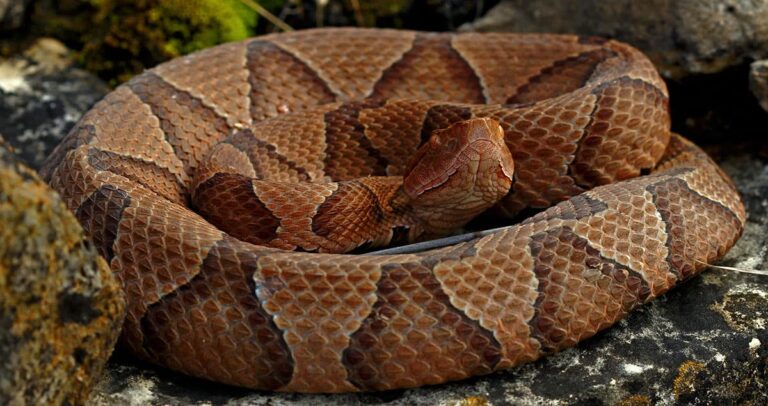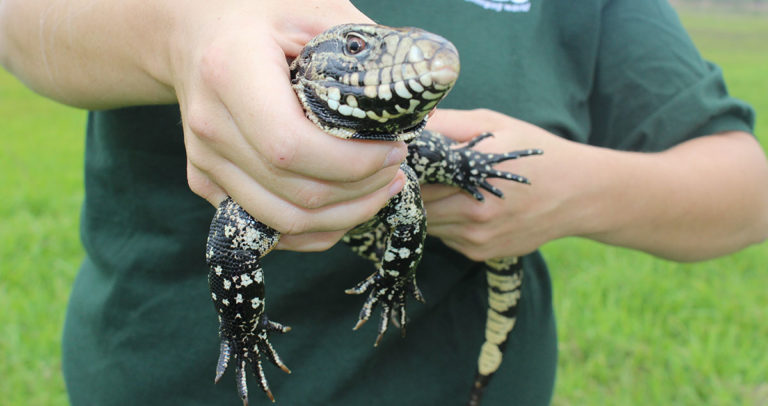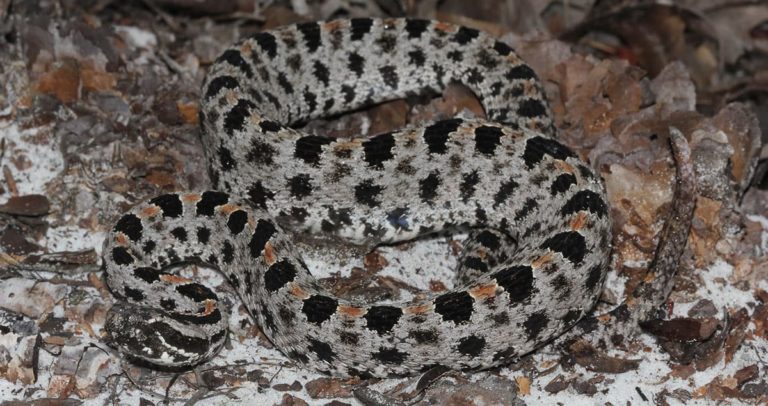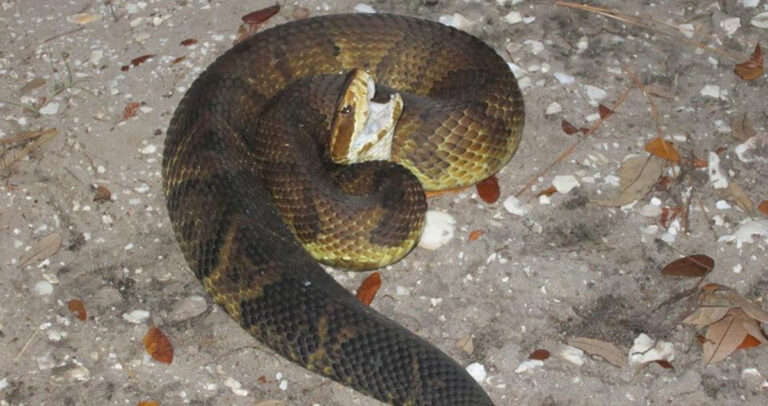Meet Georgia’s Lizards: A Guide to 7 Common Species
Lizards are a fascinating and essential part of Georgia’s wildlife, representing a diverse array of species that call the state their home. In this article, we’ll explore seven common lizards found in Georgia, delving into their unique features, behaviors, and habitats. So, let’s embark on a captivating journey to learn more about these incredible reptiles.
Eastern Fence Lizard (Sceloporus undulatus)
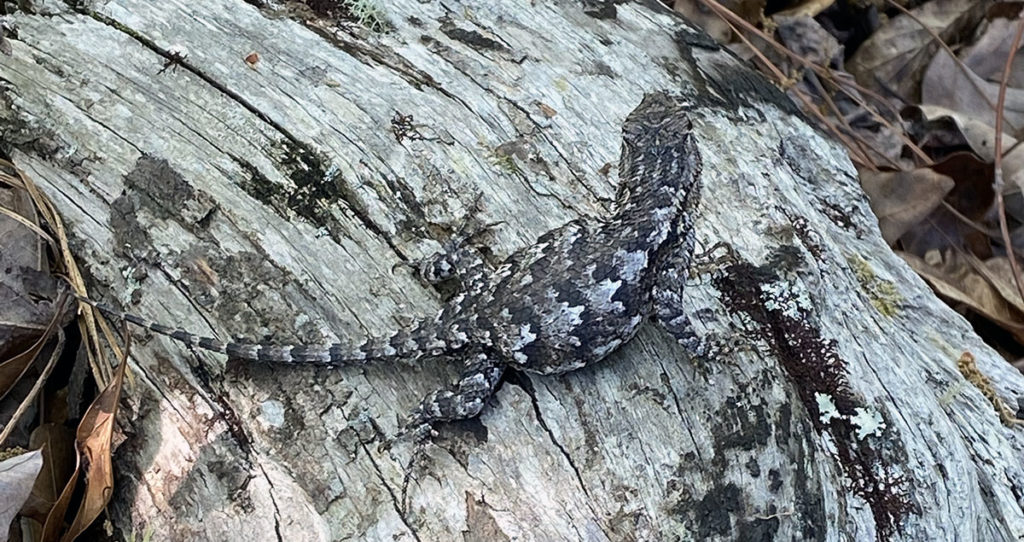
Eastern fence lizards, also known as prairie lizards, are medium-sized reptiles that can reach lengths of up to 7.5 inches. Males have a bluish hue on their throat and belly, while females display wavy, grayish-brown patterns on their backs.
Habitat
These lizards inhabit various regions across Georgia and prefer wooded areas, often found basking on tree trunks or fences. Eastern fence lizards typically make their homes in pine forests, where they can camouflage among the trees and bask in the sun.
Diet
The diet of Eastern fence lizards mainly consists of insects such as ants, beetles, spiders, and caterpillars. They are diurnal, meaning they are active during the day, and use their agile bodies and swift reflexes to catch their prey.
Uniqueness
A unique feature of Eastern fence lizards is their ability to “drop” their tails when threatened. The tail continues to wiggle, distracting predators and allowing the lizard to escape. Over time, the tail will regenerate, albeit not to its original length.
Green Anole (Anolis carolinensis)

Green anoles, also known as Carolina anoles or American chameleons, are small lizards that can grow up to 8 inches in length. Their coloration varies between bright green and brown, depending on factors such as mood, temperature, and surroundings. Males have a pinkish-red throat fan, or dewlap, which they display during territorial disputes or courtship.
Habitat
These charming lizards are commonly found in wooded areas, gardens, and suburban landscapes throughout Georgia. They prefer habitats with ample vegetation, such as trees, shrubs, and bushes, where they can easily climb and hide.
Diet
Green anoles are insectivores, feeding on a variety of insects like crickets, flies, moths, and spiders. They use their sticky, extendable tongue to snatch up their prey, making them efficient hunters.
Uniqueness
Although they are sometimes called American chameleons due to their color-changing abilities, green anoles are not true chameleons. Their color changes are limited to shades of green and brown, serving as a form of camouflage and communication.
Five-lined Skink (Plestiodon fasciatus)
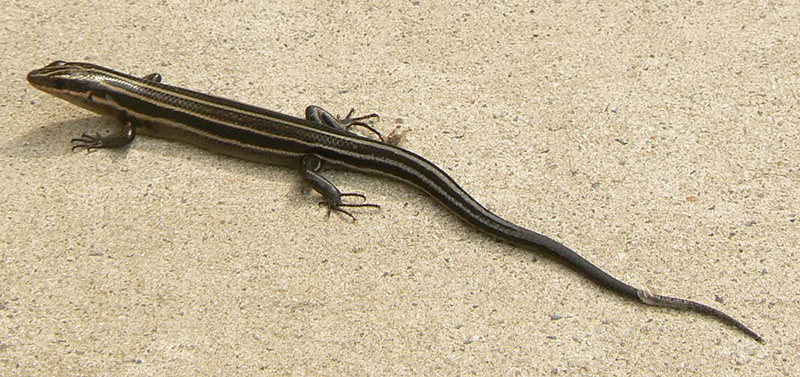
Five-lined skinks are medium-sized lizards, reaching lengths of up to 8.5 inches. They have a sleek, shiny appearance, with five light-colored stripes running the length of their dark brown or black bodies. Juveniles have a bright blue tail, which fades as they mature.
Habitat
These skinks can be found throughout Georgia, in a variety of habitats, such as forests, grasslands, and suburban areas. They are particularly fond of damp, shady environments where they can find shelter under logs, rocks, or leaf litter.
Diet
Five-lined skinks primarily feed on insects and other invertebrates, including spiders, beetles, and crickets. They are also known to eat smaller lizards, as well as the eggs and hatchlings of other reptiles.
Uniqueness
An interesting fact about five-lined skinks is their ability to autotomize, or self-amputate, their tails when threatened. Similar to the Eastern fence lizard, this defense mechanism allows the skink to escape predators, while the detached tail continues to wriggle and draw attention. The tail will eventually regenerate, though it may be shorter and differently colored than the original.
Ground Skink (Scincella lateralis)
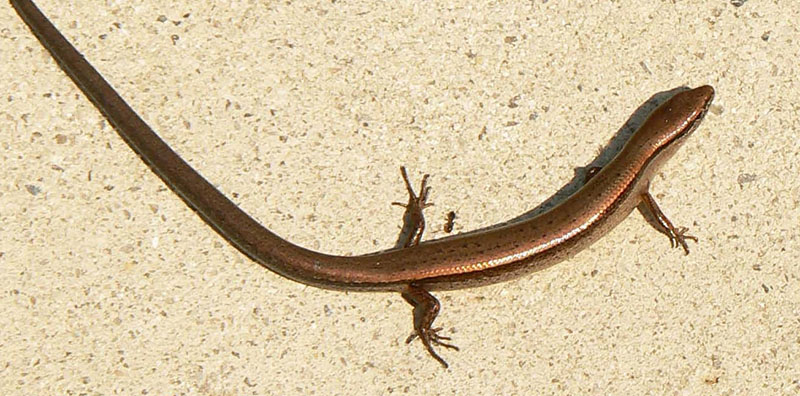
Ground skinks, also known as little brown skinks, are the smallest lizard species in Georgia, with adults reaching lengths of only 3 to 5.5 inches. Their smooth, shiny bodies are typically shades of brown or bronze, allowing them to blend in with their surroundings easily.
Habitat
These tiny reptiles can be found in various habitats across Georgia, such as forests, grasslands, and suburban yards. They prefer areas with ample ground cover, like leaf litter, rocks, or fallen logs, where they can hide from predators.
Diet
Ground skinks have a diet consisting mainly of small insects and other invertebrates, like ants, spiders, and small beetles. They use their quick reflexes and agile bodies to catch prey, often ambushing them from their hiding spots.
Uniqueness
One notable characteristic of ground skinks is their burrowing ability. They are known to dig small tunnels in the soil, leaf litter, or sand, using their strong legs and flattened bodies to maneuver through tight spaces.
Southeastern Five-lined Skink (Plestiodon inexpectatus)

The Southeastern five-lined skink is similar in appearance to the five-lined skink, with a sleek body displaying five light-colored stripes running along its dark brown or black back. Juveniles also have a blue tail, which fades to gray as they mature. Adults can grow up to 8.5 inches in length.
Habitat
These skinks inhabit various regions in Georgia, often found in wooded areas, swamps, or suburban landscapes. They prefer environments with plenty of hiding spots, such as leaf litter, fallen logs, or rock piles.
Diet
Southeastern five-lined skinks feed on a variety of insects and invertebrates, like spiders, beetles, and crickets. Occasionally, they may also consume small lizards, reptile eggs, or even small vertebrates like newborn mice.
Uniqueness
An interesting aspect of the Southeastern five-lined skink is its reproductive behavior. Unlike many other lizard species, the females exhibit parental care, guarding their eggs from predators until they hatch.
Six-lined Racerunner (Aspidoscelis sexlineata)
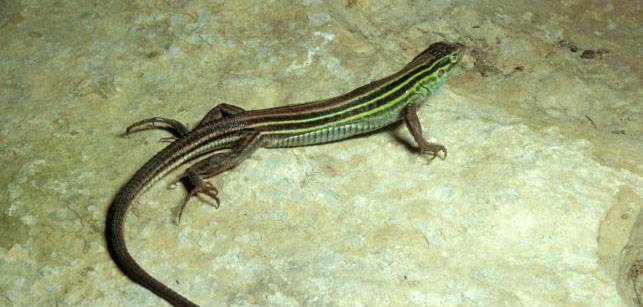
Six-lined racerunners are slender, fast-moving lizards that can grow up to 10 inches in length. They have six distinct yellow or greenish-yellow stripes running down their dark green or black bodies. Males often exhibit turquoise or green coloration on their throats and sides during the breeding season.
Habitat
These speedy lizards are found in a variety of habitats throughout Georgia, including grasslands, sandhills, and open forests. They prefer sunny, open areas with sparse vegetation, where they can bask and quickly escape predators.
Diet
Six-lined racerunners feed on a diet of insects and other invertebrates, such as grasshoppers, spiders, and beetles. Their speed and agility make them effective hunters, capable of catching even the fastest prey.
Uniqueness
An intriguing feature of six-lined racerunners is their exceptional speed. They are among the fastest lizards in North America, capable of reaching speeds of up to 18 miles per hour.
Broadhead Skink (Plestiodon laticeps)

Broadhead skinks are the largest skink species found in Georgia, with adult males reaching lengths of up to 13 inches. Their name derives from the males’ distinctive broad, triangular heads. Males also display a reddish-orange color on their head and jaws during the breeding season. The overall coloration of broadhead skinks ranges from brown to olive green, with faint, faded stripes on their backs.
Habitat
These impressive lizards inhabit various wooded habitats across Georgia, from swamps and forests to suburban areas. They prefer environments with plenty of trees and hiding spots, such as rock crevices, fallen logs, or leaf litter.
Diet
Broadhead skinks are known for their diverse diet, which includes insects, spiders, and other invertebrates, as well as smaller lizards, and even small rodents or bird eggs. Their large size and powerful jaws allow them to tackle a wide range of prey.
Uniqueness
A fascinating aspect of broadhead skinks is their climbing ability. These agile reptiles are excellent tree climbers, using their sharp claws and prehensile tails to navigate branches in search of food or shelter.
Final Thoughts
Lizards play an important role in Georgia’s ecosystems, acting as both predators and prey in the food chain. The seven species highlighted in this article represent just a fraction of the remarkable diversity of lizards found in the state. By understanding and appreciating these reptiles, we can contribute to their conservation and promote the protection of their habitats. So, next time you encounter one of these fascinating creatures in the wild, take a moment to marvel at their unique features and remember the vital role they play in maintaining a healthy environment.

